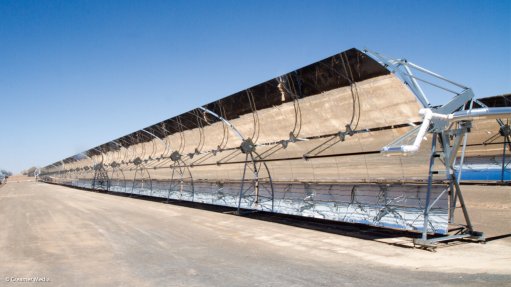
Photo by: Duane Daws
With one major concentrated solar power (CSP) plant up and running near Upington, in the Northern Cape, and another two in development, players in the CSP market see much opportunity for the industry. But they have called for greater certainty from government on its Integrated Resource Plan (IRP) update.
“We think a decrease in costs will drive a big allocation to CSP. There are thousands of potential megawatts out there,” Southern Africa Solar Thermal and Electricity Association (Sastela) chairperson Louis van Heerden told delegates at the CSP Today South Africa 2015 conference in Cape Town on Tuesday.
The IRP update has advocated for an increase in the current CSP allocation from the current 1 200 MW to 3 300 MW by 2030 and 8 100 MW by 2050. The keenly awaited IRP update was supposed to have been approved last year, but this has not yet happened.
“CSP has the potential for large-scale manufacturing, industrialisation and localisation,” Van Heerden told a packed conference room. He said CSP had become increasingly cost effective compared with conventional energy.
“CSP is now viewed as an integrated generation option, providing both baseload and peak electricity.”
Sastela believed CSP was the only renewable-energy technology capable of delivering electricity consistently during peak times when it was needed most, as it can be produced not only during the day, but also stored and supplied to the national grid at peak times.
Van Heerden said there were great benefits if the size of plants could be upscaled, while costs could be cut further.
“CSP plants are modular and can be constructed within a period of 24 to 36 months. This will allow South Africa to introduce much-needed baseload and peak power into the grid within a short space of time. Four providers, constructing 300 MW each, could deliver 1 200 MW within three to four years.”
The renewable-energy market is extremely competitive, with CSP solar, solar photovoltaic, wind energy and biomass, besides other technologies, all battling it out for their slice of the market.
Players in the CSP market see it as a very viable option, particularly as a CSP plant has a lifespan of 35 years or more, compared with a coal plant which has an estimated 20-year lifespan.
The 100 MW KaXu Solar One project in the sun-drenched Northern Cape was connected to the grid on March 2.
KaXu Solar One GM Julián Lopez Garrido said the plant had outperformed its targets so far. He was also pleased that the company had achieved over and above the local procurement targets, while he expected many small businesses would be established in the area.
However, Lopez called for a compromise from the government to help the solar CSP industry develop local skills.
“If we want local skilled people, we will need joint efforts to develop these skills.”
However, he said the Northern Cape, South Africa’s most sparsely populated province with a deep unemployment problem, would benefit from the investment.
“CSP is here to stay for the long time and we hope to be here for 30 years and beyond that. I think South Africa has the framework for this kind of development and we encourage other companies to follow this model. It is the way to go.”